Comprehensive Accounting and Finance Report: Investment Appraisal
VerifiedAdded on 2020/10/05
|15
|4043
|231
Report
AI Summary
This report provides a detailed analysis of accounting and finance principles, encompassing financial statements, break-even analysis, and investment appraisal techniques. Part A focuses on preparing an income statement and balance sheet for Gravepals Plc for 2017. Part B delves into break-even analysis, margin of safety, and Clarkenpark Ltd's strategy, including identifying and explaining assumptions within the break-even model. Part C explores investment appraisal techniques such as payback period, accounting rate of return, and net present value, offering recommendations on purchasing a new machine. The report includes calculations, explanations, and analyses of key merits and demerits for each technique, along with a discussion of budgeting as a strategic planning tool. The conclusion summarizes the key findings and recommendations, supported by a comprehensive list of references.

INTRODUCTION TO
ACCOUNTING AND FINANCE
ACCOUNTING AND FINANCE
Paraphrase This Document
Need a fresh take? Get an instant paraphrase of this document with our AI Paraphraser
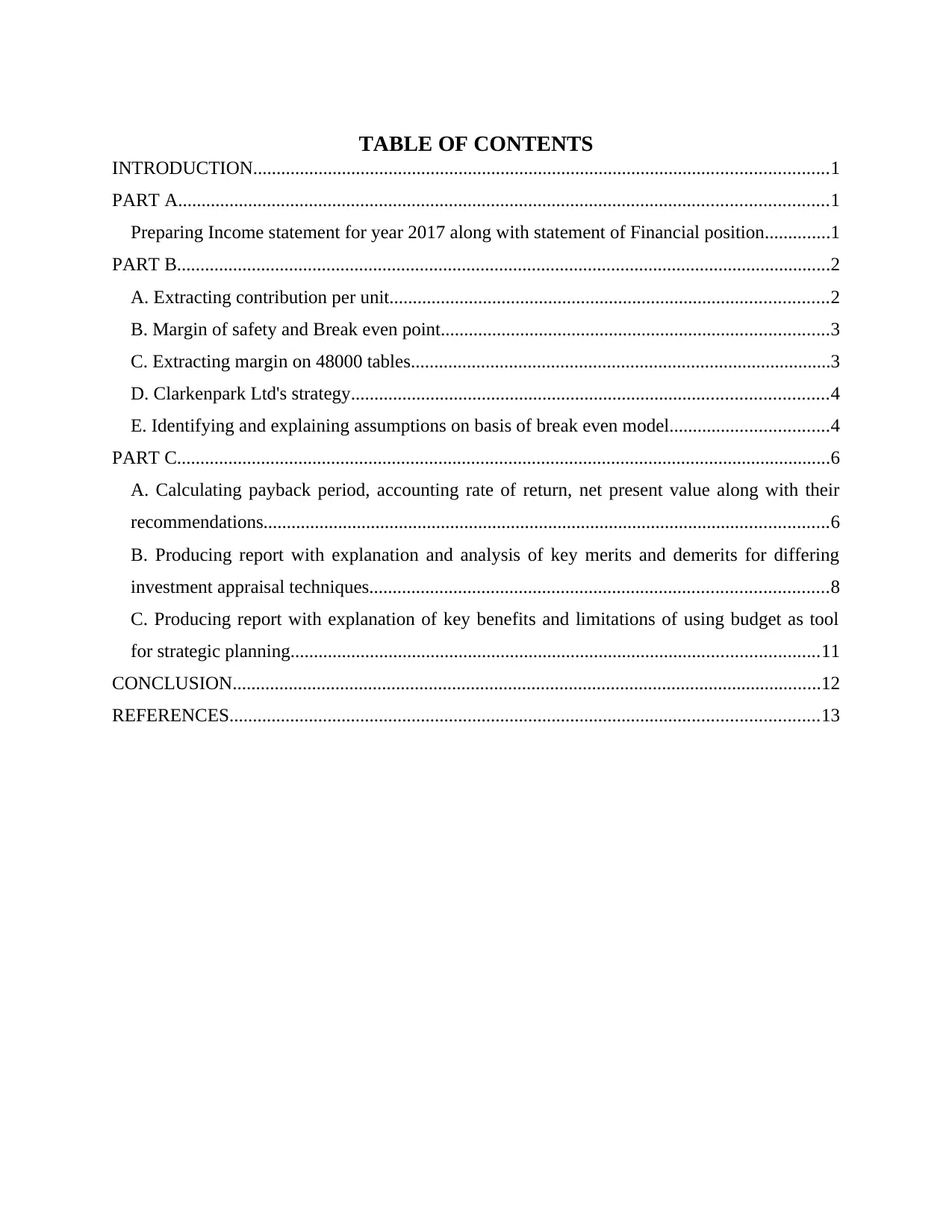
TABLE OF CONTENTS
INTRODUCTION...........................................................................................................................1
PART A...........................................................................................................................................1
Preparing Income statement for year 2017 along with statement of Financial position..............1
PART B............................................................................................................................................2
A. Extracting contribution per unit..............................................................................................2
B. Margin of safety and Break even point...................................................................................3
C. Extracting margin on 48000 tables..........................................................................................3
D. Clarkenpark Ltd's strategy......................................................................................................4
E. Identifying and explaining assumptions on basis of break even model..................................4
PART C............................................................................................................................................6
A. Calculating payback period, accounting rate of return, net present value along with their
recommendations.........................................................................................................................6
B. Producing report with explanation and analysis of key merits and demerits for differing
investment appraisal techniques..................................................................................................8
C. Producing report with explanation of key benefits and limitations of using budget as tool
for strategic planning.................................................................................................................11
CONCLUSION..............................................................................................................................12
REFERENCES..............................................................................................................................13
INTRODUCTION...........................................................................................................................1
PART A...........................................................................................................................................1
Preparing Income statement for year 2017 along with statement of Financial position..............1
PART B............................................................................................................................................2
A. Extracting contribution per unit..............................................................................................2
B. Margin of safety and Break even point...................................................................................3
C. Extracting margin on 48000 tables..........................................................................................3
D. Clarkenpark Ltd's strategy......................................................................................................4
E. Identifying and explaining assumptions on basis of break even model..................................4
PART C............................................................................................................................................6
A. Calculating payback period, accounting rate of return, net present value along with their
recommendations.........................................................................................................................6
B. Producing report with explanation and analysis of key merits and demerits for differing
investment appraisal techniques..................................................................................................8
C. Producing report with explanation of key benefits and limitations of using budget as tool
for strategic planning.................................................................................................................11
CONCLUSION..............................................................................................................................12
REFERENCES..............................................................................................................................13
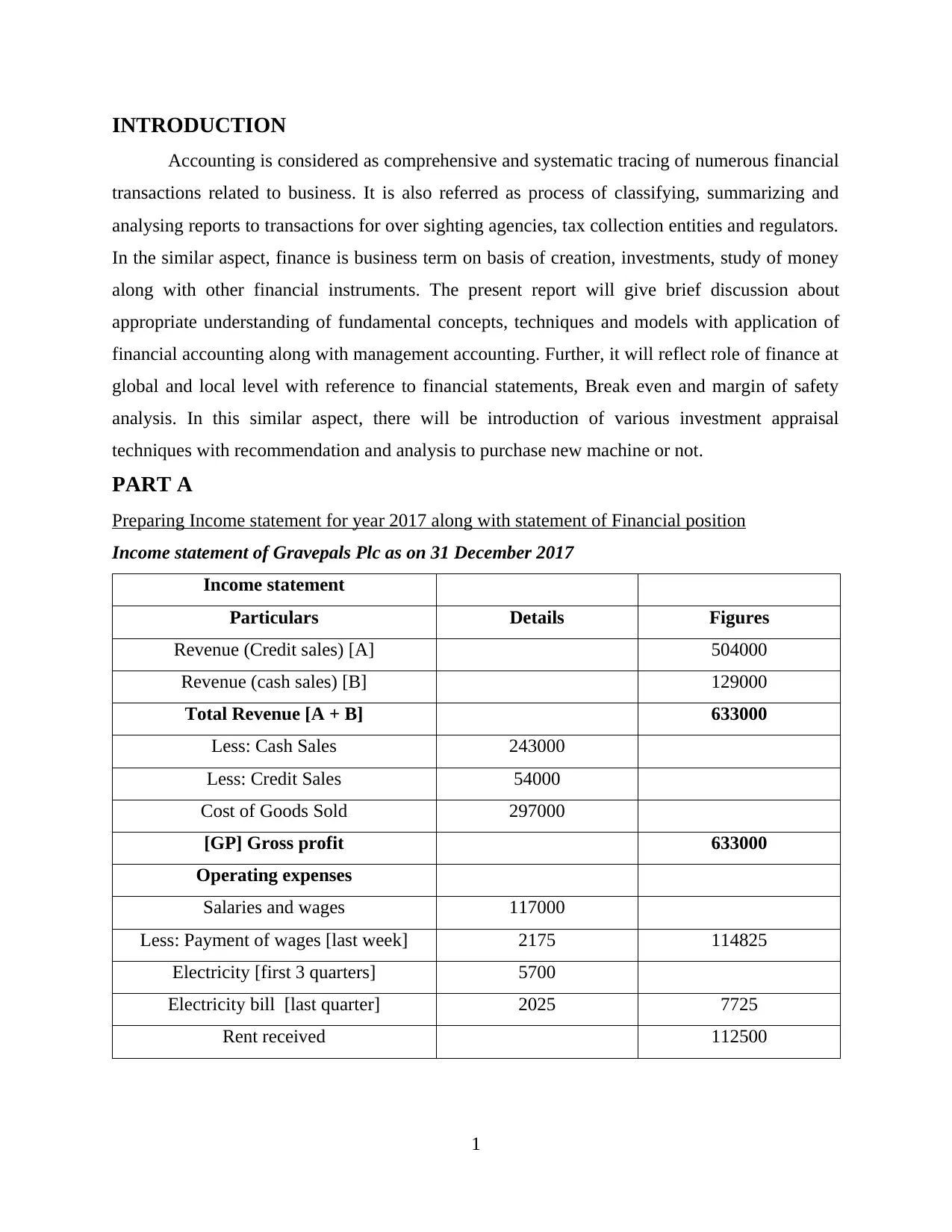
INTRODUCTION
Accounting is considered as comprehensive and systematic tracing of numerous financial
transactions related to business. It is also referred as process of classifying, summarizing and
analysing reports to transactions for over sighting agencies, tax collection entities and regulators.
In the similar aspect, finance is business term on basis of creation, investments, study of money
along with other financial instruments. The present report will give brief discussion about
appropriate understanding of fundamental concepts, techniques and models with application of
financial accounting along with management accounting. Further, it will reflect role of finance at
global and local level with reference to financial statements, Break even and margin of safety
analysis. In this similar aspect, there will be introduction of various investment appraisal
techniques with recommendation and analysis to purchase new machine or not.
PART A
Preparing Income statement for year 2017 along with statement of Financial position
Income statement of Gravepals Plc as on 31 December 2017
Income statement
Particulars Details Figures
Revenue (Credit sales) [A] 504000
Revenue (cash sales) [B] 129000
Total Revenue [A + B] 633000
Less: Cash Sales 243000
Less: Credit Sales 54000
Cost of Goods Sold 297000
[GP] Gross profit 633000
Operating expenses
Salaries and wages 117000
Less: Payment of wages [last week] 2175 114825
Electricity [first 3 quarters] 5700
Electricity bill [last quarter] 2025 7725
Rent received 112500
1
Accounting is considered as comprehensive and systematic tracing of numerous financial
transactions related to business. It is also referred as process of classifying, summarizing and
analysing reports to transactions for over sighting agencies, tax collection entities and regulators.
In the similar aspect, finance is business term on basis of creation, investments, study of money
along with other financial instruments. The present report will give brief discussion about
appropriate understanding of fundamental concepts, techniques and models with application of
financial accounting along with management accounting. Further, it will reflect role of finance at
global and local level with reference to financial statements, Break even and margin of safety
analysis. In this similar aspect, there will be introduction of various investment appraisal
techniques with recommendation and analysis to purchase new machine or not.
PART A
Preparing Income statement for year 2017 along with statement of Financial position
Income statement of Gravepals Plc as on 31 December 2017
Income statement
Particulars Details Figures
Revenue (Credit sales) [A] 504000
Revenue (cash sales) [B] 129000
Total Revenue [A + B] 633000
Less: Cash Sales 243000
Less: Credit Sales 54000
Cost of Goods Sold 297000
[GP] Gross profit 633000
Operating expenses
Salaries and wages 117000
Less: Payment of wages [last week] 2175 114825
Electricity [first 3 quarters] 5700
Electricity bill [last quarter] 2025 7725
Rent received 112500
1
⊘ This is a preview!⊘
Do you want full access?
Subscribe today to unlock all pages.

Trusted by 1+ million students worldwide
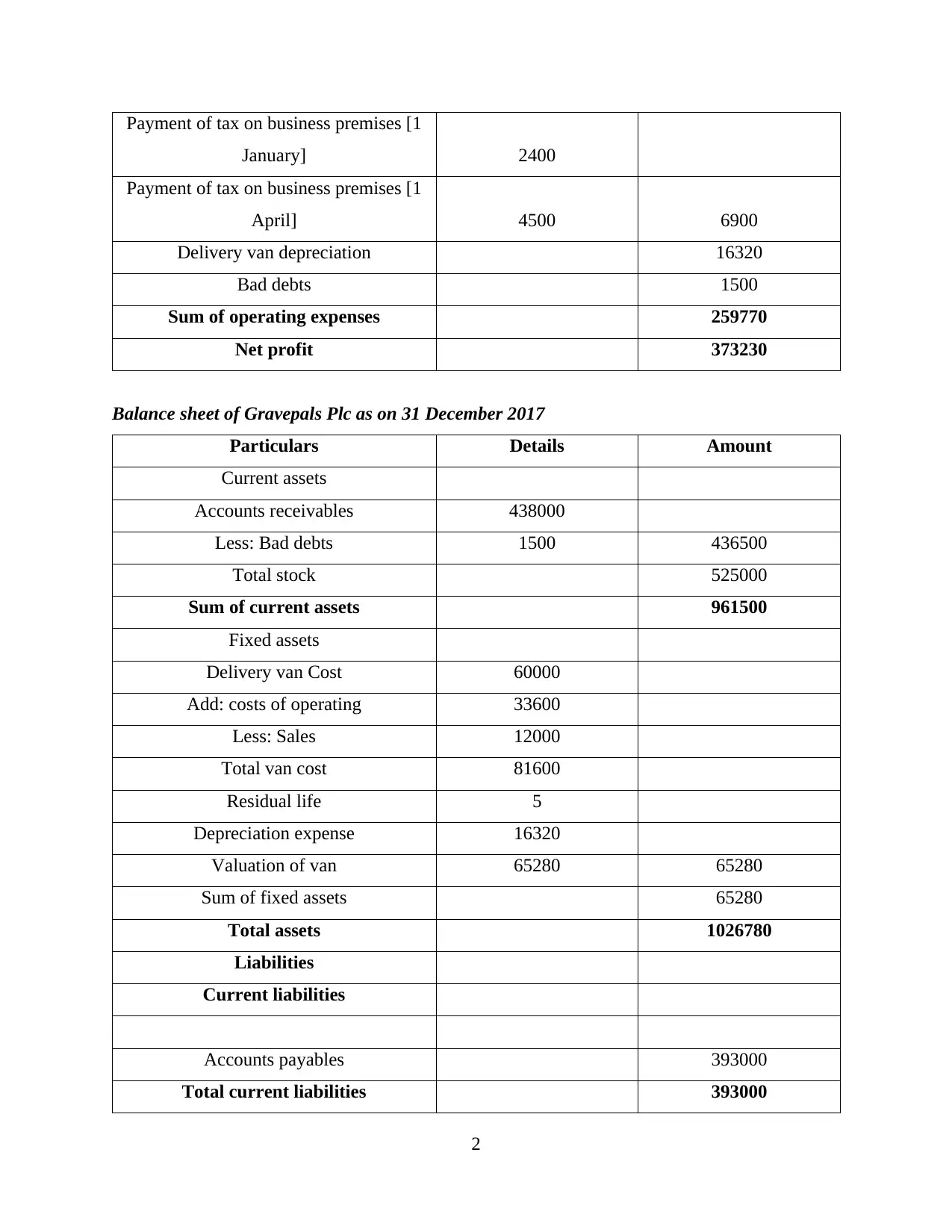
Payment of tax on business premises [1
January] 2400
Payment of tax on business premises [1
April] 4500 6900
Delivery van depreciation 16320
Bad debts 1500
Sum of operating expenses 259770
Net profit 373230
Balance sheet of Gravepals Plc as on 31 December 2017
Particulars Details Amount
Current assets
Accounts receivables 438000
Less: Bad debts 1500 436500
Total stock 525000
Sum of current assets 961500
Fixed assets
Delivery van Cost 60000
Add: costs of operating 33600
Less: Sales 12000
Total van cost 81600
Residual life 5
Depreciation expense 16320
Valuation of van 65280 65280
Sum of fixed assets 65280
Total assets 1026780
Liabilities
Current liabilities
Accounts payables 393000
Total current liabilities 393000
2
January] 2400
Payment of tax on business premises [1
April] 4500 6900
Delivery van depreciation 16320
Bad debts 1500
Sum of operating expenses 259770
Net profit 373230
Balance sheet of Gravepals Plc as on 31 December 2017
Particulars Details Amount
Current assets
Accounts receivables 438000
Less: Bad debts 1500 436500
Total stock 525000
Sum of current assets 961500
Fixed assets
Delivery van Cost 60000
Add: costs of operating 33600
Less: Sales 12000
Total van cost 81600
Residual life 5
Depreciation expense 16320
Valuation of van 65280 65280
Sum of fixed assets 65280
Total assets 1026780
Liabilities
Current liabilities
Accounts payables 393000
Total current liabilities 393000
2
Paraphrase This Document
Need a fresh take? Get an instant paraphrase of this document with our AI Paraphraser
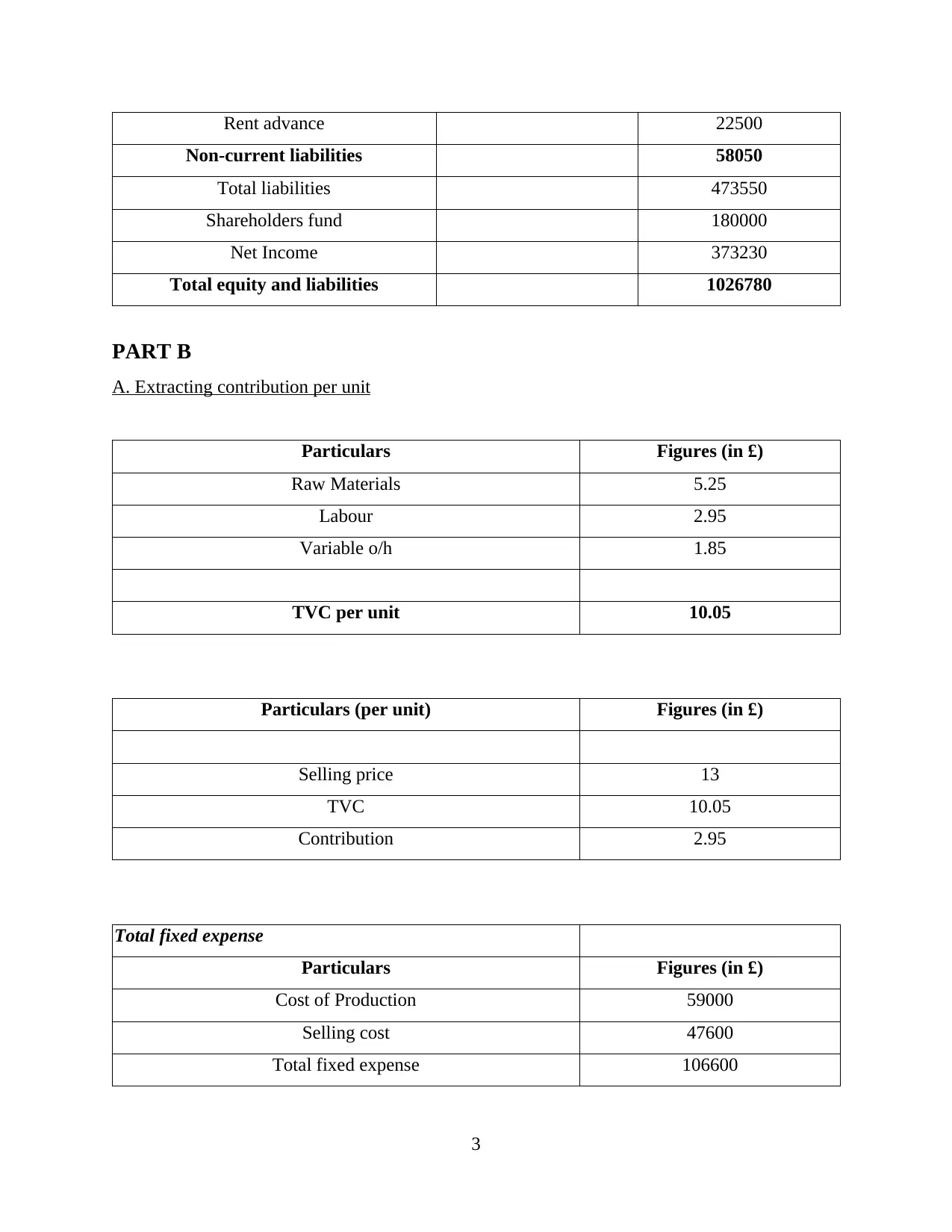
Rent advance 22500
Non-current liabilities 58050
Total liabilities 473550
Shareholders fund 180000
Net Income 373230
Total equity and liabilities 1026780
PART B
A. Extracting contribution per unit
Particulars Figures (in £)
Raw Materials 5.25
Labour 2.95
Variable o/h 1.85
TVC per unit 10.05
Particulars (per unit) Figures (in £)
Selling price 13
TVC 10.05
Contribution 2.95
Total fixed expense
Particulars Figures (in £)
Cost of Production 59000
Selling cost 47600
Total fixed expense 106600
3
Non-current liabilities 58050
Total liabilities 473550
Shareholders fund 180000
Net Income 373230
Total equity and liabilities 1026780
PART B
A. Extracting contribution per unit
Particulars Figures (in £)
Raw Materials 5.25
Labour 2.95
Variable o/h 1.85
TVC per unit 10.05
Particulars (per unit) Figures (in £)
Selling price 13
TVC 10.05
Contribution 2.95
Total fixed expense
Particulars Figures (in £)
Cost of Production 59000
Selling cost 47600
Total fixed expense 106600
3
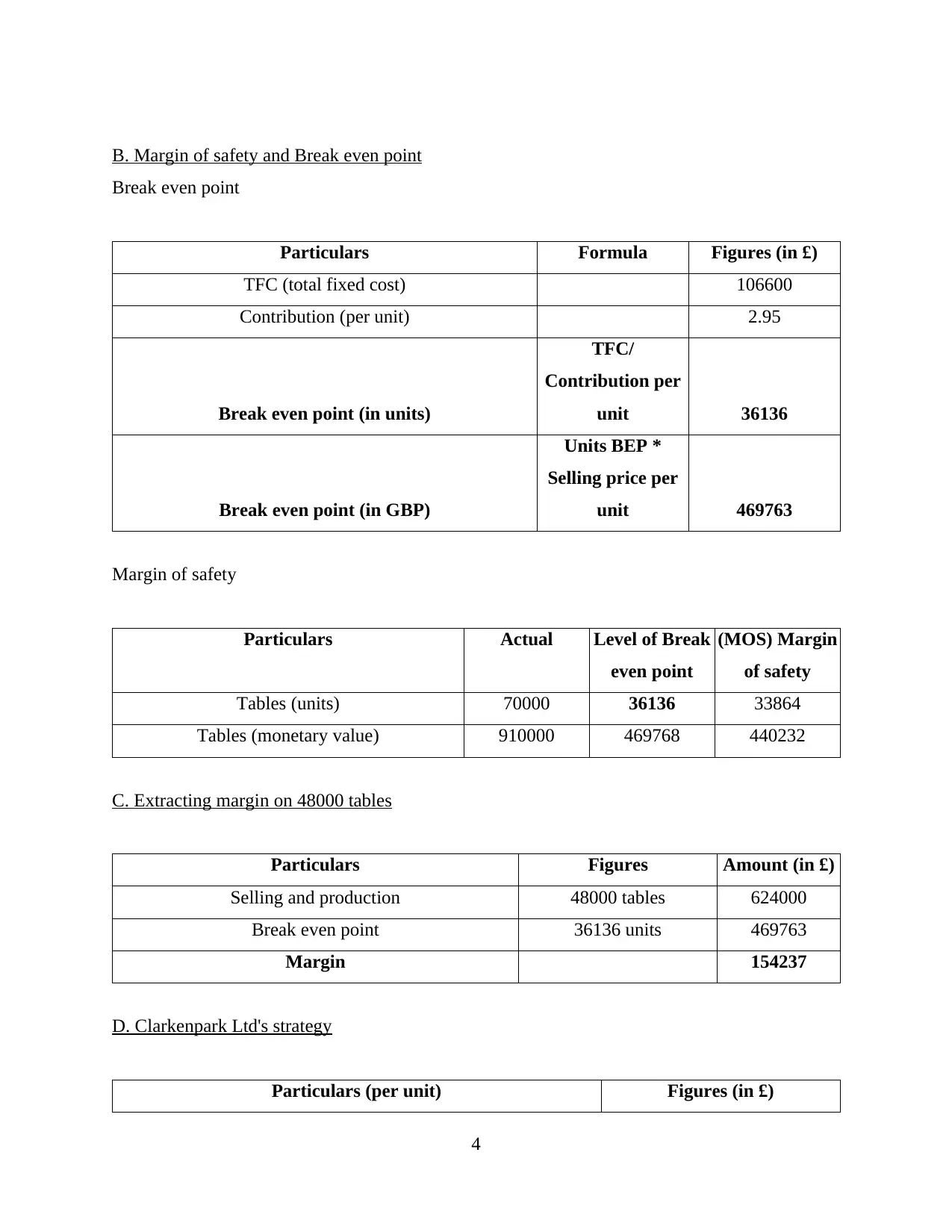
B. Margin of safety and Break even point
Break even point
Particulars Formula Figures (in £)
TFC (total fixed cost) 106600
Contribution (per unit) 2.95
Break even point (in units)
TFC/
Contribution per
unit 36136
Break even point (in GBP)
Units BEP *
Selling price per
unit 469763
Margin of safety
Particulars Actual Level of Break
even point
(MOS) Margin
of safety
Tables (units) 70000 36136 33864
Tables (monetary value) 910000 469768 440232
C. Extracting margin on 48000 tables
Particulars Figures Amount (in £)
Selling and production 48000 tables 624000
Break even point 36136 units 469763
Margin 154237
D. Clarkenpark Ltd's strategy
Particulars (per unit) Figures (in £)
4
Break even point
Particulars Formula Figures (in £)
TFC (total fixed cost) 106600
Contribution (per unit) 2.95
Break even point (in units)
TFC/
Contribution per
unit 36136
Break even point (in GBP)
Units BEP *
Selling price per
unit 469763
Margin of safety
Particulars Actual Level of Break
even point
(MOS) Margin
of safety
Tables (units) 70000 36136 33864
Tables (monetary value) 910000 469768 440232
C. Extracting margin on 48000 tables
Particulars Figures Amount (in £)
Selling and production 48000 tables 624000
Break even point 36136 units 469763
Margin 154237
D. Clarkenpark Ltd's strategy
Particulars (per unit) Figures (in £)
4
⊘ This is a preview!⊘
Do you want full access?
Subscribe today to unlock all pages.

Trusted by 1+ million students worldwide
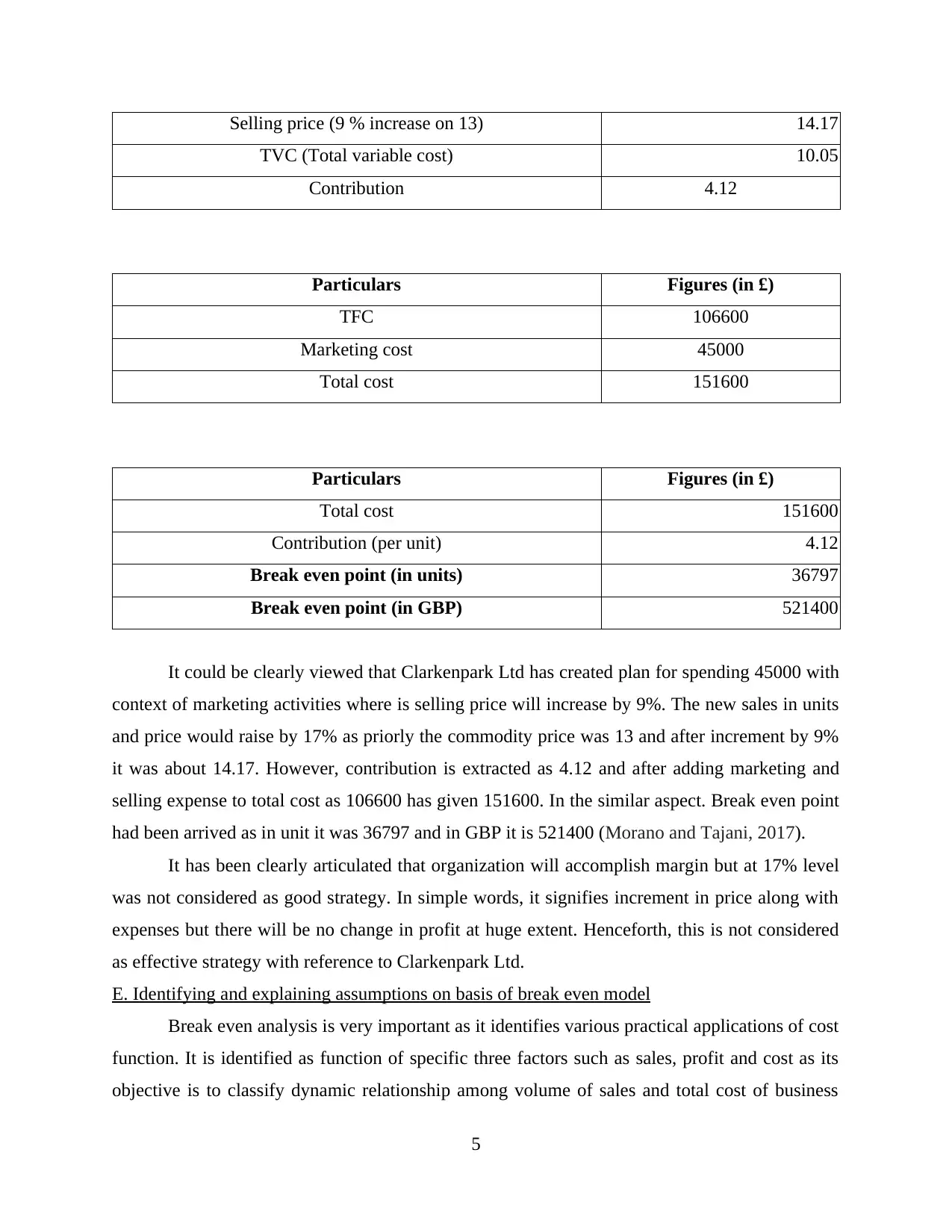
Selling price (9 % increase on 13) 14.17
TVC (Total variable cost) 10.05
Contribution 4.12
Particulars Figures (in £)
TFC 106600
Marketing cost 45000
Total cost 151600
Particulars Figures (in £)
Total cost 151600
Contribution (per unit) 4.12
Break even point (in units) 36797
Break even point (in GBP) 521400
It could be clearly viewed that Clarkenpark Ltd has created plan for spending 45000 with
context of marketing activities where is selling price will increase by 9%. The new sales in units
and price would raise by 17% as priorly the commodity price was 13 and after increment by 9%
it was about 14.17. However, contribution is extracted as 4.12 and after adding marketing and
selling expense to total cost as 106600 has given 151600. In the similar aspect. Break even point
had been arrived as in unit it was 36797 and in GBP it is 521400 (Morano and Tajani, 2017).
It has been clearly articulated that organization will accomplish margin but at 17% level
was not considered as good strategy. In simple words, it signifies increment in price along with
expenses but there will be no change in profit at huge extent. Henceforth, this is not considered
as effective strategy with reference to Clarkenpark Ltd.
E. Identifying and explaining assumptions on basis of break even model
Break even analysis is very important as it identifies various practical applications of cost
function. It is identified as function of specific three factors such as sales, profit and cost as its
objective is to classify dynamic relationship among volume of sales and total cost of business
5
TVC (Total variable cost) 10.05
Contribution 4.12
Particulars Figures (in £)
TFC 106600
Marketing cost 45000
Total cost 151600
Particulars Figures (in £)
Total cost 151600
Contribution (per unit) 4.12
Break even point (in units) 36797
Break even point (in GBP) 521400
It could be clearly viewed that Clarkenpark Ltd has created plan for spending 45000 with
context of marketing activities where is selling price will increase by 9%. The new sales in units
and price would raise by 17% as priorly the commodity price was 13 and after increment by 9%
it was about 14.17. However, contribution is extracted as 4.12 and after adding marketing and
selling expense to total cost as 106600 has given 151600. In the similar aspect. Break even point
had been arrived as in unit it was 36797 and in GBP it is 521400 (Morano and Tajani, 2017).
It has been clearly articulated that organization will accomplish margin but at 17% level
was not considered as good strategy. In simple words, it signifies increment in price along with
expenses but there will be no change in profit at huge extent. Henceforth, this is not considered
as effective strategy with reference to Clarkenpark Ltd.
E. Identifying and explaining assumptions on basis of break even model
Break even analysis is very important as it identifies various practical applications of cost
function. It is identified as function of specific three factors such as sales, profit and cost as its
objective is to classify dynamic relationship among volume of sales and total cost of business
5
Paraphrase This Document
Need a fresh take? Get an instant paraphrase of this document with our AI Paraphraser
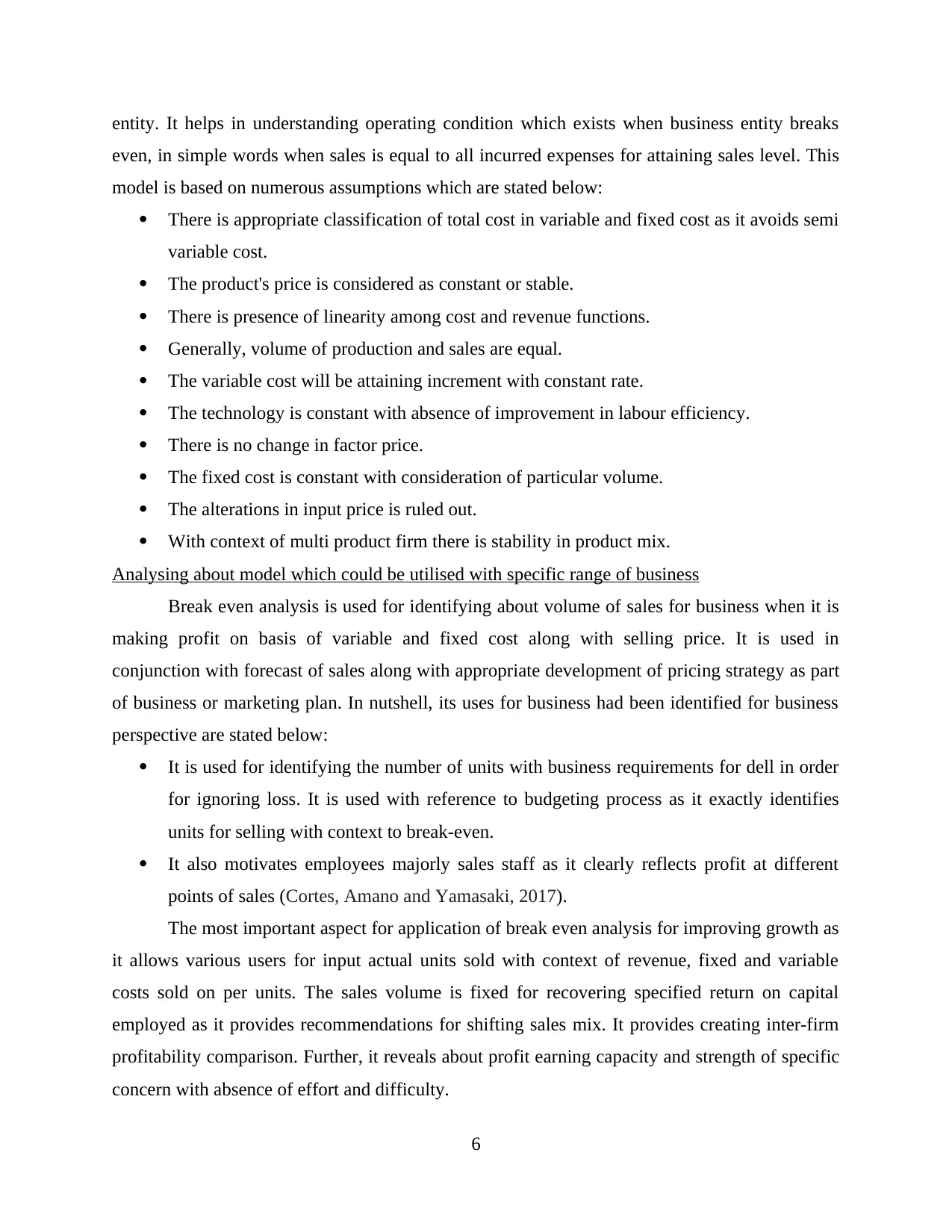
entity. It helps in understanding operating condition which exists when business entity breaks
even, in simple words when sales is equal to all incurred expenses for attaining sales level. This
model is based on numerous assumptions which are stated below:
There is appropriate classification of total cost in variable and fixed cost as it avoids semi
variable cost.
The product's price is considered as constant or stable.
There is presence of linearity among cost and revenue functions.
Generally, volume of production and sales are equal.
The variable cost will be attaining increment with constant rate.
The technology is constant with absence of improvement in labour efficiency.
There is no change in factor price.
The fixed cost is constant with consideration of particular volume.
The alterations in input price is ruled out.
With context of multi product firm there is stability in product mix.
Analysing about model which could be utilised with specific range of business
Break even analysis is used for identifying about volume of sales for business when it is
making profit on basis of variable and fixed cost along with selling price. It is used in
conjunction with forecast of sales along with appropriate development of pricing strategy as part
of business or marketing plan. In nutshell, its uses for business had been identified for business
perspective are stated below:
It is used for identifying the number of units with business requirements for dell in order
for ignoring loss. It is used with reference to budgeting process as it exactly identifies
units for selling with context to break-even.
It also motivates employees majorly sales staff as it clearly reflects profit at different
points of sales (Cortes, Amano and Yamasaki, 2017).
The most important aspect for application of break even analysis for improving growth as
it allows various users for input actual units sold with context of revenue, fixed and variable
costs sold on per units. The sales volume is fixed for recovering specified return on capital
employed as it provides recommendations for shifting sales mix. It provides creating inter-firm
profitability comparison. Further, it reveals about profit earning capacity and strength of specific
concern with absence of effort and difficulty.
6
even, in simple words when sales is equal to all incurred expenses for attaining sales level. This
model is based on numerous assumptions which are stated below:
There is appropriate classification of total cost in variable and fixed cost as it avoids semi
variable cost.
The product's price is considered as constant or stable.
There is presence of linearity among cost and revenue functions.
Generally, volume of production and sales are equal.
The variable cost will be attaining increment with constant rate.
The technology is constant with absence of improvement in labour efficiency.
There is no change in factor price.
The fixed cost is constant with consideration of particular volume.
The alterations in input price is ruled out.
With context of multi product firm there is stability in product mix.
Analysing about model which could be utilised with specific range of business
Break even analysis is used for identifying about volume of sales for business when it is
making profit on basis of variable and fixed cost along with selling price. It is used in
conjunction with forecast of sales along with appropriate development of pricing strategy as part
of business or marketing plan. In nutshell, its uses for business had been identified for business
perspective are stated below:
It is used for identifying the number of units with business requirements for dell in order
for ignoring loss. It is used with reference to budgeting process as it exactly identifies
units for selling with context to break-even.
It also motivates employees majorly sales staff as it clearly reflects profit at different
points of sales (Cortes, Amano and Yamasaki, 2017).
The most important aspect for application of break even analysis for improving growth as
it allows various users for input actual units sold with context of revenue, fixed and variable
costs sold on per units. The sales volume is fixed for recovering specified return on capital
employed as it provides recommendations for shifting sales mix. It provides creating inter-firm
profitability comparison. Further, it reveals about profit earning capacity and strength of specific
concern with absence of effort and difficulty.
6
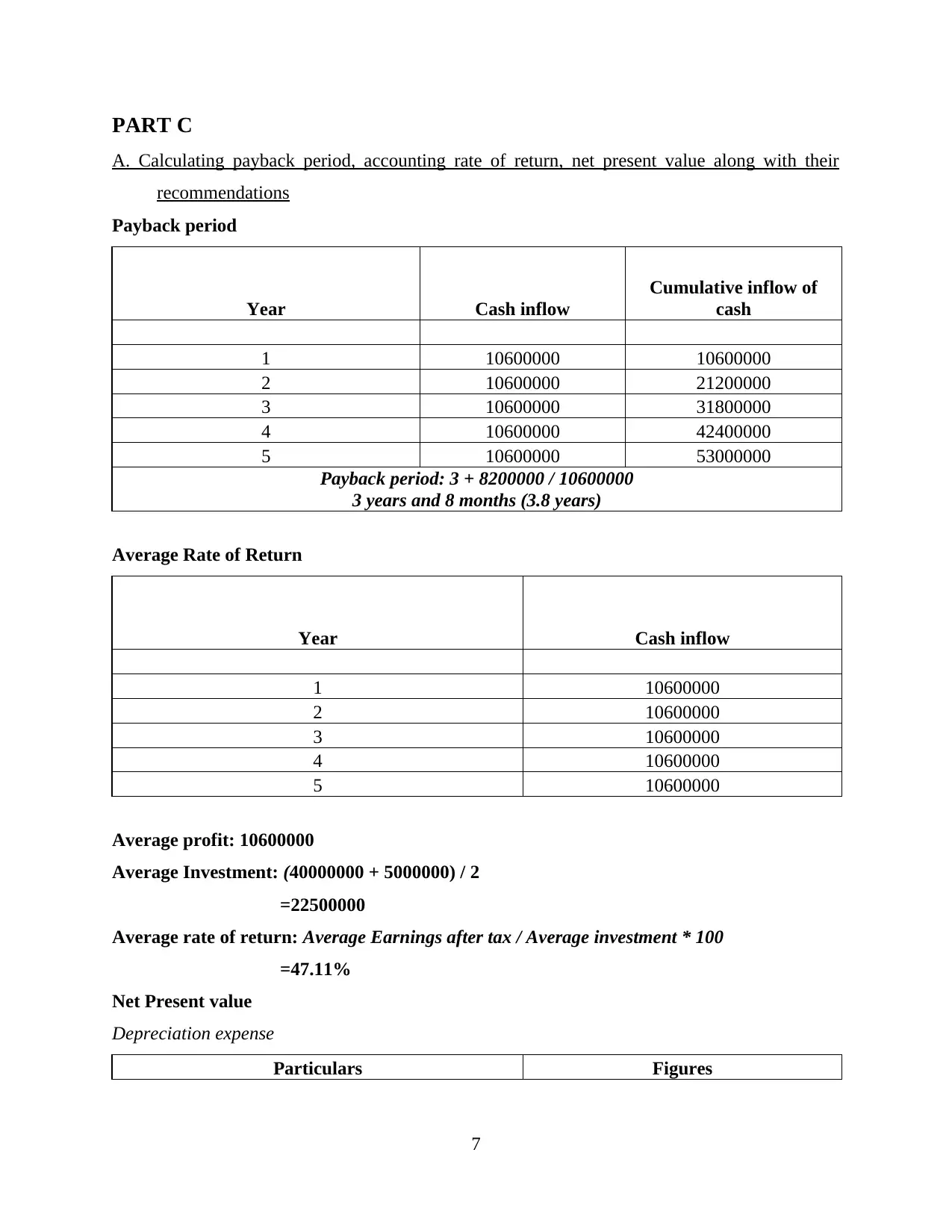
PART C
A. Calculating payback period, accounting rate of return, net present value along with their
recommendations
Payback period
Year Cash inflow
Cumulative inflow of
cash
1 10600000 10600000
2 10600000 21200000
3 10600000 31800000
4 10600000 42400000
5 10600000 53000000
Payback period: 3 + 8200000 / 10600000
3 years and 8 months (3.8 years)
Average Rate of Return
Year Cash inflow
1 10600000
2 10600000
3 10600000
4 10600000
5 10600000
Average profit: 10600000
Average Investment: (40000000 + 5000000) / 2
=22500000
Average rate of return: Average Earnings after tax / Average investment * 100
=47.11%
Net Present value
Depreciation expense
Particulars Figures
7
A. Calculating payback period, accounting rate of return, net present value along with their
recommendations
Payback period
Year Cash inflow
Cumulative inflow of
cash
1 10600000 10600000
2 10600000 21200000
3 10600000 31800000
4 10600000 42400000
5 10600000 53000000
Payback period: 3 + 8200000 / 10600000
3 years and 8 months (3.8 years)
Average Rate of Return
Year Cash inflow
1 10600000
2 10600000
3 10600000
4 10600000
5 10600000
Average profit: 10600000
Average Investment: (40000000 + 5000000) / 2
=22500000
Average rate of return: Average Earnings after tax / Average investment * 100
=47.11%
Net Present value
Depreciation expense
Particulars Figures
7
⊘ This is a preview!⊘
Do you want full access?
Subscribe today to unlock all pages.

Trusted by 1+ million students worldwide
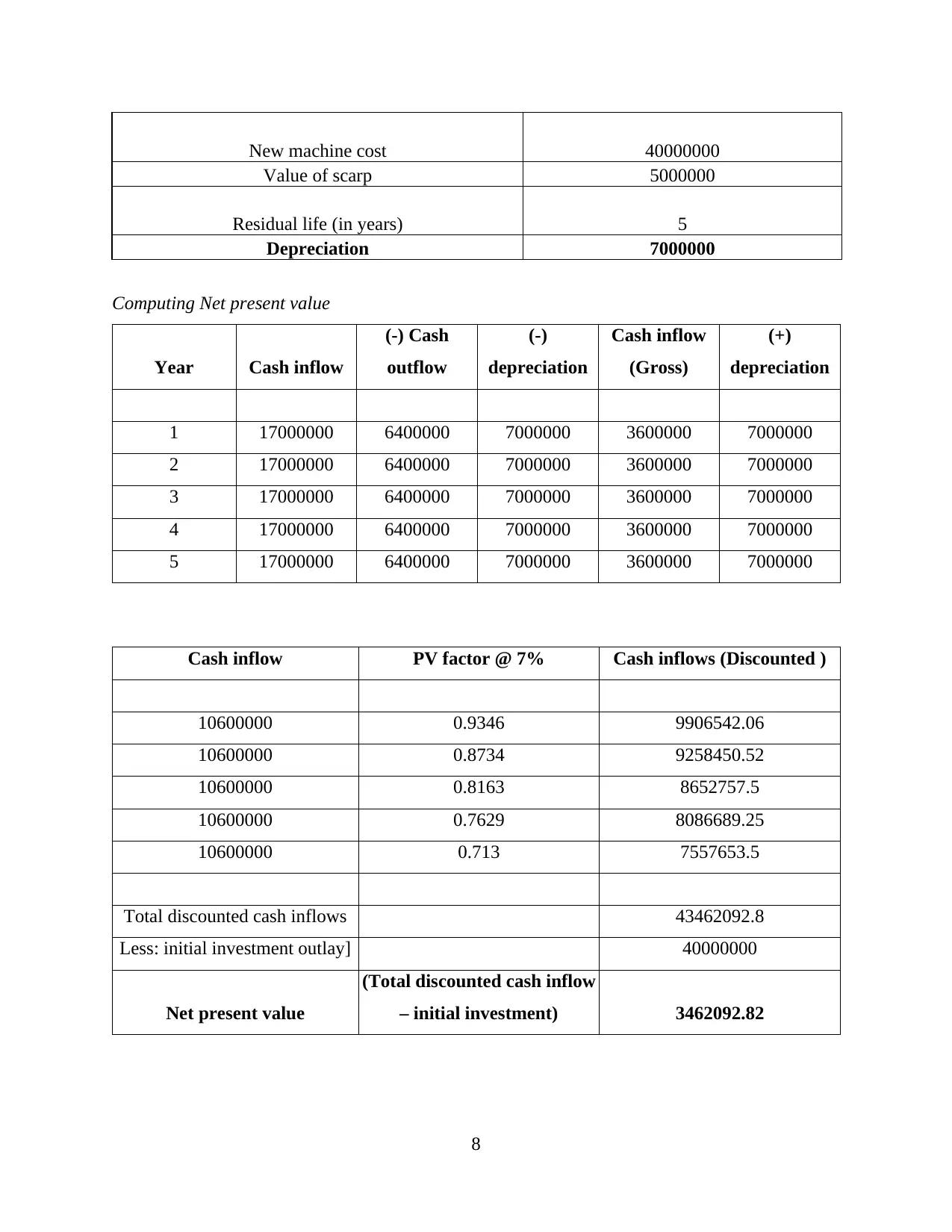
New machine cost 40000000
Value of scarp 5000000
Residual life (in years) 5
Depreciation 7000000
Computing Net present value
Year Cash inflow
(-) Cash
outflow
(-)
depreciation
Cash inflow
(Gross)
(+)
depreciation
1 17000000 6400000 7000000 3600000 7000000
2 17000000 6400000 7000000 3600000 7000000
3 17000000 6400000 7000000 3600000 7000000
4 17000000 6400000 7000000 3600000 7000000
5 17000000 6400000 7000000 3600000 7000000
Cash inflow PV factor @ 7% Cash inflows (Discounted )
10600000 0.9346 9906542.06
10600000 0.8734 9258450.52
10600000 0.8163 8652757.5
10600000 0.7629 8086689.25
10600000 0.713 7557653.5
Total discounted cash inflows 43462092.8
Less: initial investment outlay] 40000000
Net present value
(Total discounted cash inflow
– initial investment) 3462092.82
8
Value of scarp 5000000
Residual life (in years) 5
Depreciation 7000000
Computing Net present value
Year Cash inflow
(-) Cash
outflow
(-)
depreciation
Cash inflow
(Gross)
(+)
depreciation
1 17000000 6400000 7000000 3600000 7000000
2 17000000 6400000 7000000 3600000 7000000
3 17000000 6400000 7000000 3600000 7000000
4 17000000 6400000 7000000 3600000 7000000
5 17000000 6400000 7000000 3600000 7000000
Cash inflow PV factor @ 7% Cash inflows (Discounted )
10600000 0.9346 9906542.06
10600000 0.8734 9258450.52
10600000 0.8163 8652757.5
10600000 0.7629 8086689.25
10600000 0.713 7557653.5
Total discounted cash inflows 43462092.8
Less: initial investment outlay] 40000000
Net present value
(Total discounted cash inflow
– initial investment) 3462092.82
8
Paraphrase This Document
Need a fresh take? Get an instant paraphrase of this document with our AI Paraphraser
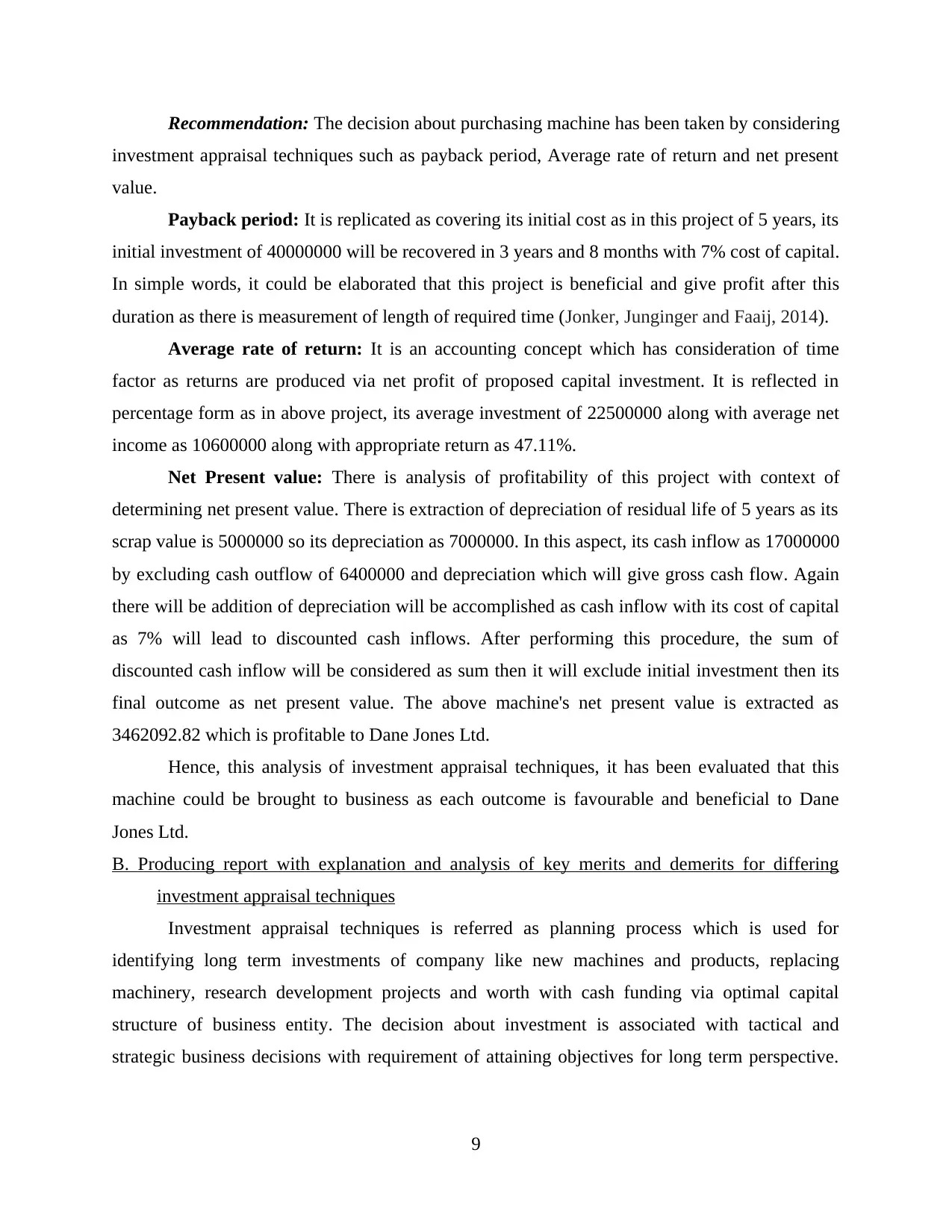
Recommendation: The decision about purchasing machine has been taken by considering
investment appraisal techniques such as payback period, Average rate of return and net present
value.
Payback period: It is replicated as covering its initial cost as in this project of 5 years, its
initial investment of 40000000 will be recovered in 3 years and 8 months with 7% cost of capital.
In simple words, it could be elaborated that this project is beneficial and give profit after this
duration as there is measurement of length of required time (Jonker, Junginger and Faaij, 2014).
Average rate of return: It is an accounting concept which has consideration of time
factor as returns are produced via net profit of proposed capital investment. It is reflected in
percentage form as in above project, its average investment of 22500000 along with average net
income as 10600000 along with appropriate return as 47.11%.
Net Present value: There is analysis of profitability of this project with context of
determining net present value. There is extraction of depreciation of residual life of 5 years as its
scrap value is 5000000 so its depreciation as 7000000. In this aspect, its cash inflow as 17000000
by excluding cash outflow of 6400000 and depreciation which will give gross cash flow. Again
there will be addition of depreciation will be accomplished as cash inflow with its cost of capital
as 7% will lead to discounted cash inflows. After performing this procedure, the sum of
discounted cash inflow will be considered as sum then it will exclude initial investment then its
final outcome as net present value. The above machine's net present value is extracted as
3462092.82 which is profitable to Dane Jones Ltd.
Hence, this analysis of investment appraisal techniques, it has been evaluated that this
machine could be brought to business as each outcome is favourable and beneficial to Dane
Jones Ltd.
B. Producing report with explanation and analysis of key merits and demerits for differing
investment appraisal techniques
Investment appraisal techniques is referred as planning process which is used for
identifying long term investments of company like new machines and products, replacing
machinery, research development projects and worth with cash funding via optimal capital
structure of business entity. The decision about investment is associated with tactical and
strategic business decisions with requirement of attaining objectives for long term perspective.
9
investment appraisal techniques such as payback period, Average rate of return and net present
value.
Payback period: It is replicated as covering its initial cost as in this project of 5 years, its
initial investment of 40000000 will be recovered in 3 years and 8 months with 7% cost of capital.
In simple words, it could be elaborated that this project is beneficial and give profit after this
duration as there is measurement of length of required time (Jonker, Junginger and Faaij, 2014).
Average rate of return: It is an accounting concept which has consideration of time
factor as returns are produced via net profit of proposed capital investment. It is reflected in
percentage form as in above project, its average investment of 22500000 along with average net
income as 10600000 along with appropriate return as 47.11%.
Net Present value: There is analysis of profitability of this project with context of
determining net present value. There is extraction of depreciation of residual life of 5 years as its
scrap value is 5000000 so its depreciation as 7000000. In this aspect, its cash inflow as 17000000
by excluding cash outflow of 6400000 and depreciation which will give gross cash flow. Again
there will be addition of depreciation will be accomplished as cash inflow with its cost of capital
as 7% will lead to discounted cash inflows. After performing this procedure, the sum of
discounted cash inflow will be considered as sum then it will exclude initial investment then its
final outcome as net present value. The above machine's net present value is extracted as
3462092.82 which is profitable to Dane Jones Ltd.
Hence, this analysis of investment appraisal techniques, it has been evaluated that this
machine could be brought to business as each outcome is favourable and beneficial to Dane
Jones Ltd.
B. Producing report with explanation and analysis of key merits and demerits for differing
investment appraisal techniques
Investment appraisal techniques is referred as planning process which is used for
identifying long term investments of company like new machines and products, replacing
machinery, research development projects and worth with cash funding via optimal capital
structure of business entity. The decision about investment is associated with tactical and
strategic business decisions with requirement of attaining objectives for long term perspective.
9
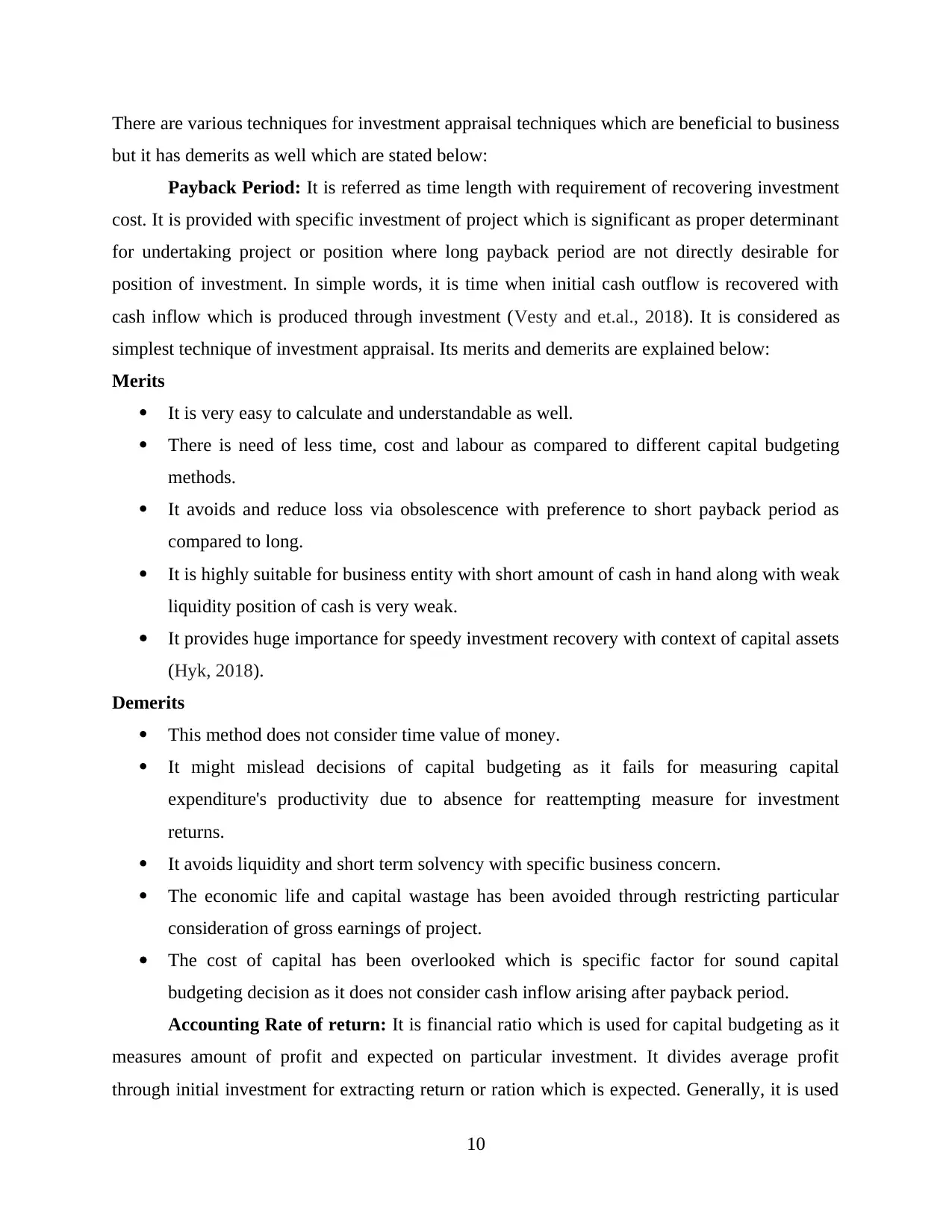
There are various techniques for investment appraisal techniques which are beneficial to business
but it has demerits as well which are stated below:
Payback Period: It is referred as time length with requirement of recovering investment
cost. It is provided with specific investment of project which is significant as proper determinant
for undertaking project or position where long payback period are not directly desirable for
position of investment. In simple words, it is time when initial cash outflow is recovered with
cash inflow which is produced through investment (Vesty and et.al., 2018). It is considered as
simplest technique of investment appraisal. Its merits and demerits are explained below:
Merits
It is very easy to calculate and understandable as well.
There is need of less time, cost and labour as compared to different capital budgeting
methods.
It avoids and reduce loss via obsolescence with preference to short payback period as
compared to long.
It is highly suitable for business entity with short amount of cash in hand along with weak
liquidity position of cash is very weak.
It provides huge importance for speedy investment recovery with context of capital assets
(Hyk, 2018).
Demerits
This method does not consider time value of money.
It might mislead decisions of capital budgeting as it fails for measuring capital
expenditure's productivity due to absence for reattempting measure for investment
returns.
It avoids liquidity and short term solvency with specific business concern.
The economic life and capital wastage has been avoided through restricting particular
consideration of gross earnings of project.
The cost of capital has been overlooked which is specific factor for sound capital
budgeting decision as it does not consider cash inflow arising after payback period.
Accounting Rate of return: It is financial ratio which is used for capital budgeting as it
measures amount of profit and expected on particular investment. It divides average profit
through initial investment for extracting return or ration which is expected. Generally, it is used
10
but it has demerits as well which are stated below:
Payback Period: It is referred as time length with requirement of recovering investment
cost. It is provided with specific investment of project which is significant as proper determinant
for undertaking project or position where long payback period are not directly desirable for
position of investment. In simple words, it is time when initial cash outflow is recovered with
cash inflow which is produced through investment (Vesty and et.al., 2018). It is considered as
simplest technique of investment appraisal. Its merits and demerits are explained below:
Merits
It is very easy to calculate and understandable as well.
There is need of less time, cost and labour as compared to different capital budgeting
methods.
It avoids and reduce loss via obsolescence with preference to short payback period as
compared to long.
It is highly suitable for business entity with short amount of cash in hand along with weak
liquidity position of cash is very weak.
It provides huge importance for speedy investment recovery with context of capital assets
(Hyk, 2018).
Demerits
This method does not consider time value of money.
It might mislead decisions of capital budgeting as it fails for measuring capital
expenditure's productivity due to absence for reattempting measure for investment
returns.
It avoids liquidity and short term solvency with specific business concern.
The economic life and capital wastage has been avoided through restricting particular
consideration of gross earnings of project.
The cost of capital has been overlooked which is specific factor for sound capital
budgeting decision as it does not consider cash inflow arising after payback period.
Accounting Rate of return: It is financial ratio which is used for capital budgeting as it
measures amount of profit and expected on particular investment. It divides average profit
through initial investment for extracting return or ration which is expected. Generally, it is used
10
⊘ This is a preview!⊘
Do you want full access?
Subscribe today to unlock all pages.

Trusted by 1+ million students worldwide
1 out of 15
Related Documents
Your All-in-One AI-Powered Toolkit for Academic Success.
+13062052269
info@desklib.com
Available 24*7 on WhatsApp / Email
![[object Object]](/_next/static/media/star-bottom.7253800d.svg)
Unlock your academic potential
Copyright © 2020–2025 A2Z Services. All Rights Reserved. Developed and managed by ZUCOL.




